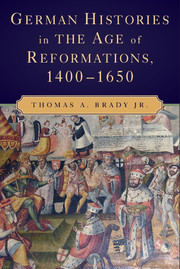Book contents
- Frontmatter
- Contents
- Figures, Maps, and Tables
- Acknowledgments
- A Note on Usages
- Map 1 The Empire in 1547
- Map 2 The Peace of Westphalia, 1648
- Part I The Empire, the German Lands, and Their Peoples
- Part II Reform of the Empire and the Church, 1400–1520
- Part III Church, Reformations, and Empire, 1520–1576
- Part IV Confessions, Empire, and War, 1576–1650
- Appendix
- Glossary
- Bibliography
- Index
Part II - Reform of the Empire and the Church, 1400–1520
Published online by Cambridge University Press: 05 June 2012
- Frontmatter
- Contents
- Figures, Maps, and Tables
- Acknowledgments
- A Note on Usages
- Map 1 The Empire in 1547
- Map 2 The Peace of Westphalia, 1648
- Part I The Empire, the German Lands, and Their Peoples
- Part II Reform of the Empire and the Church, 1400–1520
- Part III Church, Reformations, and Empire, 1520–1576
- Part IV Confessions, Empire, and War, 1576–1650
- Appendix
- Glossary
- Bibliography
- Index
Summary
A mortal disease has befallen the German Empire; if it is not speedily treated, death will inexorably ensue. Men will seek for the realm of Germany and will not find; and in time strangers will seize our habitations and divide them among themselves. So we shall be subjected to another nation.
Nicholas of CusaPart II begins the narrative that fills most of this book. Its central theme is the problem of the reform of the Empire and the Church during the decades between 1400 and 1520. The chapters play out two great stories. The first story consists of the actual reforms in governance, successful in the Empire but not in the Church. The reforms emerged not under the inspiration of ideas, such as the Church being a model for the Empire, but as a series of concrete changes inspired by political and military needs. The possibility of change depended on the king-emperor and his leading vassals coming willy-nilly to terms as co-regents of the Empire. One great change made political reforms: the institutionalization of dynastic power over specific, feudal but heritable lands, or, in a word, territorialization. Unlike their Luxemburg predecessors, the two Habsburg king-emperors of this era managed to consolidate their rule over a cluster of dynastic territories. The Austrian lands served them as a base for advancing dynastic interests in the Empire as a whole.
- Type
- Chapter
- Information
- German Histories in the Age of Reformations, 1400–1650 , pp. 69 - 70Publisher: Cambridge University PressPrint publication year: 2009
- 1
- Cited by



